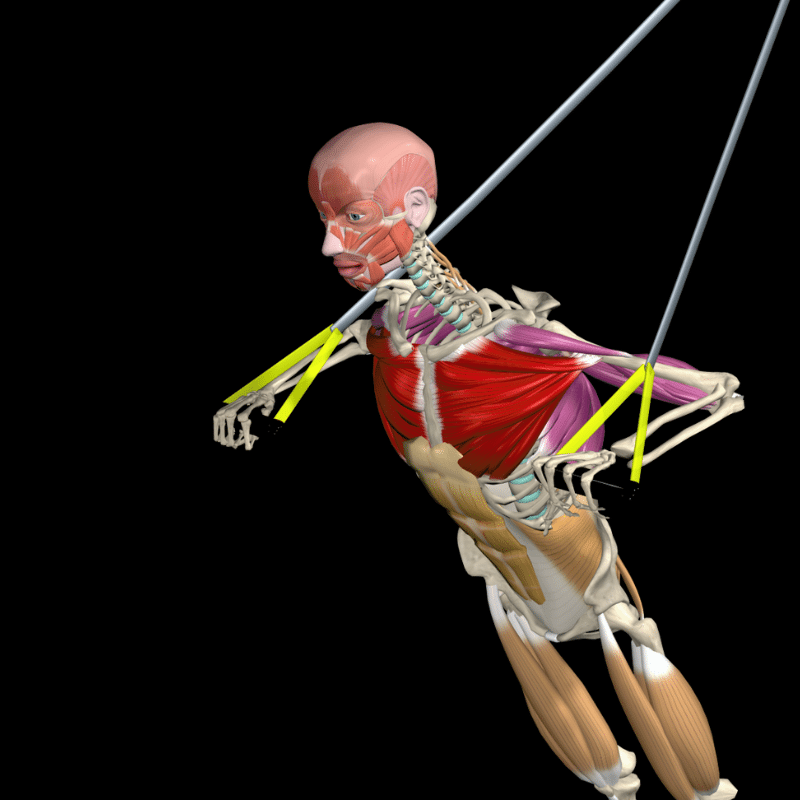Suspension (straps) exercises have gained immense popularity in recent years thanks to their ability to provide a full-body workout that enhances strength stability. Their compact size and user-friendly design make suspension exercise systems highly portable, which makes them a convenient option for a wide range of users, from seasoned athletes to those just starting their fitness journey.
In this Muscle and Motion article, we will explore the benefits and the science behind suspension training and how you can incorporate them into your training routine.
The fundamentals of suspension training
Suspension training was developed by a former U.S. Navy SEAL, Randy Hetrick, as a way to maintain peak physical condition while deployed in areas without access to traditional gym equipment. This innovative form of training utilizes straps or ropes anchored to a fixed point, allowing individuals to leverage their own body weight for resistance. While suspension exercises may appear simple, there’s a wealth of science behind their effectiveness.
The benefits of suspension training
Resistance training offers numerous advantages that apply across various exercise methods and modalities. To build muscle mass, the specific equipment used is less crucial than ensuring progressively challenging loads over time. For a deeper understanding of resistance training, read “The Importance of Strength Training” article. Now, let’s focus on the distinct benefits of incorporating suspension training into your fitness routine.
- Improved joint stability
When you perform suspension exercises, your body is often unstable. You must engage multiple muscle groups to maintain balance, which leads to increased muscle engagement. This instability requires the core muscles to work harder to stabilize the body, improving joint stability. For example, in cases of shoulder instability, it will be beneficial to do shoulder exercises, such as push-ups with straps. This type of exercise not only strengthens the chest muscles but also targets and fortifies the muscles that stabilize the shoulder, thereby aiding in the prevention of further instability.
- Proprioceptive enhancement
Proprioception is the body’s ability to sense its position in space and adjust accordingly. Suspension training enhances proprioception by constantly challenging the body’s balance and spatial orientation. This leads to better body awareness and coordination in everyday activities and sports.
- Balance
Suspension training effectively enhances balance by enabling users to shift their center of gravity beyond their base of support without the risk of falling, thus providing a safe environment for stability exercises. This method is particularly beneficial for older adults, serving as a preventive measure against falls. Utilizing straps during these exercises allows for near-fall scenarios to be safely encountered and navigated, offering an optimal balance-improvement experience within a secure setting. For example, in cases of imbalance when standing on one leg, try to use exercises such as a single-leg squat with straps to improve balance and maintain safety.
- Neuromuscular benefits
Suspension exercises improve neuromuscular coordination, which is the ability of the nervous system to coordinate the muscles to perform complex movements. The instability of the straps forces the body to make constant adjustments, engaging both the primary muscle groups involved in the movement and the stabilizing muscles that might not be as engaged in stable conditions.
- Increased core stability
The core is more than just the abdominal muscles; it includes all the muscles of the lower back, hips, and pelvis. Suspension exercises require the activation of the entire core to stabilize the body, which in turn can enhance overall performance.
- Versatility and adaptability
One of the most significant advantages of suspension exercises is their versatility. The difficulty of the exercises can be modified by adjusting the body’s angle relative to the ground or by changing the base of support (e.g., performing an exercise on one leg instead of two).
In summary, suspension training is a dynamic and adaptable workout strategy that enhances muscular stability, core strength, and balance. The ability to modify exercise difficulty makes it suitable for all fitness levels, offering a unique approach to full-body conditioning. Whether for athletic enhancement or general health, incorporating suspension exercises into a fitness routine can yield substantial benefits in physical well-being.
For many other suspension exercises (straps), explore our Strength Training App.
To experience the advantages firsthand, we invite you to try our Suspension Training Program.
At Muscle and Motion, we believe that knowledge is power, and understanding the ‘why’ behind any exercise is essential for your long-term success.
Let the Strength Training App help you achieve your goals! Sign up for free.


